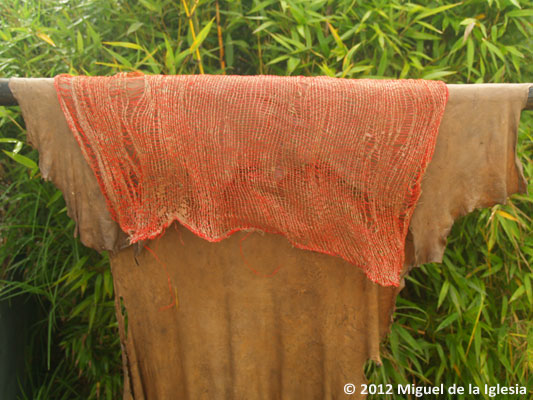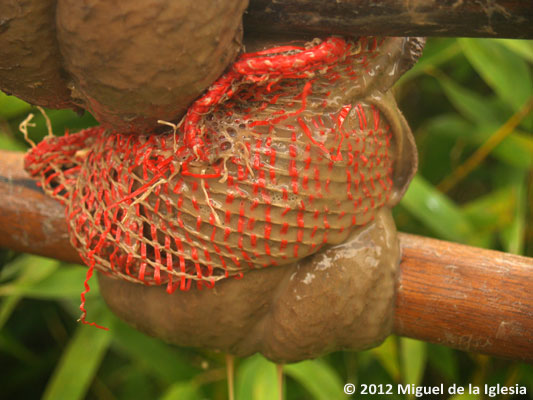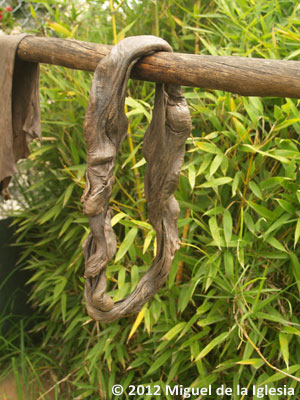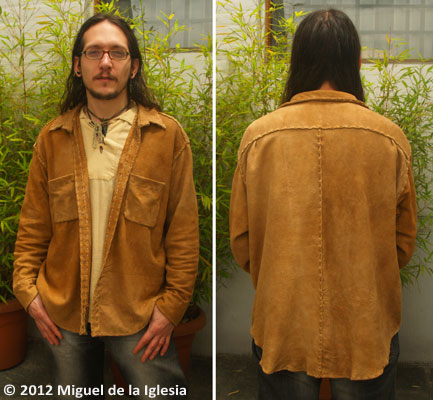
Living in Ecuador, I don't have much access to deer hides. We have deer, the same species as in the United States, Odocoileus virginianus, but the population is not very big and there is not much hunting. However, I can go to the slaughter house and get enough number of goat hides to survive with. The people at the slaughter house make quite a few knife scars when skinning the animals. The goats here are smaller and have thinner skins than in the States due to the warmer climate, but they are the best option as a deer substitute around here.
Working with such small hides, one of the big problems I usually come across is the wringing. These hides are so small that the ring of hide almost always comes apart during this step; plus they are often too slippery, all of this resulting in a poor wringing job and a continuous hopeless feeling.
Given the nature of these hides, I was forced to develop a way to effectively wring them. I had read that covering the slippery hide with some leaves or grass would help, and I used that method for a while. At first I covered the whole hide with grass and dried bamboo leafs, which were the only ones I had on hand, as I understood it was the abrasive factor that did the job. After a few hides I realized that it was more the tension factor doing the job of holding things together, and started to use large/long quicuyo (grass) stalks laid on top of the hide in the same direction as the stick used to roll the hide, that is, right before starting to create the twin rings that will meet in the middle. Then include the grass stalks in the rings while rolling them up.

I laid the grass stalks on top of the hide right before creating the twin rings.

Rings of hide with some of the stalks included inside them sticking out.
I found this method useful, but not very reliable. It helped, but failed a lot, and pretty soon I was running out of the best quicuyo stalks to do it. So I thought about it as too complicated a process to continue repeatedly with dozens of hides, and moreover, I needed a large source of long grass stalks!
I kept thinking about it and came to the conclusion that if the ability to maintain tension was what I was looking for, and needed something long and abundant to anchor the hide efficiently, the shape I was looking for was a net. I took a piece of a mesh bag that I happened to have around for felting and tested the idea with a very slippery hide I was dealing with by the time. It worked great! I was able to wring the hide all the way through in my first try. Even loosely ringing the hide, I could effectively squeeze all the water from it with all my strength. The net worked perfectly, as it combined the abrasion factor needed to grasp the hide effectively, the resistance to tension mimicking multiple grass stalks all together, and its stretchy nature, that matched perfectly with that of the hide.
After some experience with this new technique, I learned the basics. The net has to be big enough and long enough to cover as much area of the hide as possible. Don't worry if it is too big for certain small hides, or that it sticks out during the wringing, it won't hurt at all. It also needs to be woven with a very strong material, as it will have to resist a lot of tension with every hide wringing. Plastic works great, but I would also try some strong natural fibers as hemp, dogbane or raffia (Raphia sp.). They won't last as long, though. The size of the hole in the netting must be on the large side, to avoid the net getting too closed during the stretching part of the wringing, becoming a barrier to the brain solution to penetrating the interior of the hide. It is best to have the two opposite sides of the net a little thicker than the rest, so they get hooked into the core of each ring.

How to lay the net on the hide. The two opposite sides of the net must be a little thicker than the rest, so they get hooked in the core of each ring.

Brain solution coming through in an area of the hide where the wringing net can be seen during the wringing.

A well-wrung hide using the wringing net.
Another big advantage of using this wringing net is that it keeps parts of the hide plagued with holes from making them bigger during the process due to the hide going through them. No matter how big the hole is, it is covered with the net, allowing only liquid to pass through. Using this method, it's difficult to distinguish the feeling of the net breaking from that of the hide breaking during the process. So, you have to be very careful to not exert too much tension when wringing thin hides.
I think this could be a big improvement in this step of the brain tanning process. It could help especially with hides that are too small or are particularly slippery for a reliable wringing. I hope you find it useful and I encourage people to keep experimenting with it. All I can say is that when working with my goatskins, I can't imagine wringing them again without using a wringing net.


The tanned hides made into shirt and pants.
E-mail your comments to "Miguel de la Iglesia" at migueldelaiglesia@gmail.com
A former version of this article was also published in The Bulleting of Primitive Technology (Spring 2013, #45).
We hope the information on the PrimitiveWays website is both instructional and enjoyable. Understand that no warranty or guarantee is included. We expect adults to act responsibly and children to be supervised by a responsible adult. If you use the information on this site to create your own projects or if you try techniques described on PrimitiveWays, behave in accordance with applicable laws, and think about the sustainability of natural resources. Using tools or techniques described on PrimitiveWays can be dangerous with exposure to heavy, sharp or pointed objects, fire, stone tools and hazards present in outdoor settings. Without proper care and caution, or if done incorrectly, there is a risk of property damage, personal injury or even death. So, be advised: Anyone using any information provided on the PrimitiveWays website assumes responsibility for using proper care and caution to protect property, the life, health and safety of himself or herself and all others. He or she expressly assumes all risk of harm or damage to all persons or property proximately caused by the use of this information.
© PrimitiveWays 2014